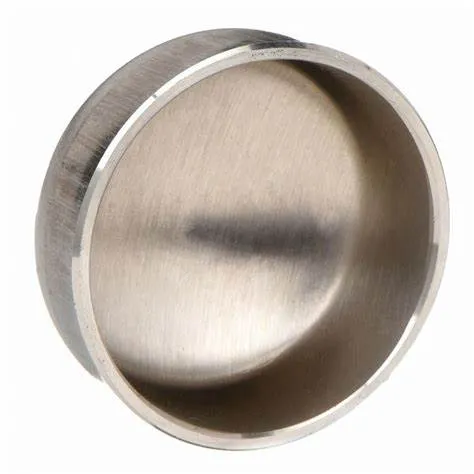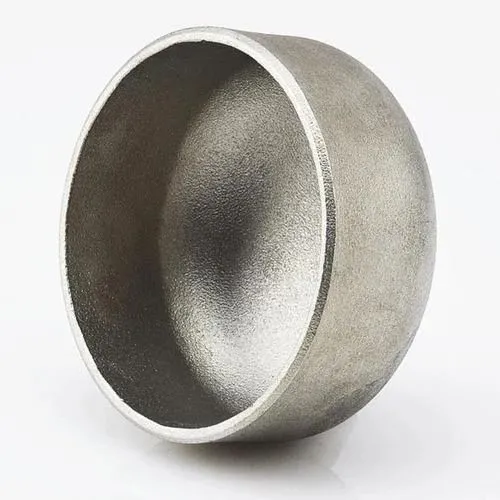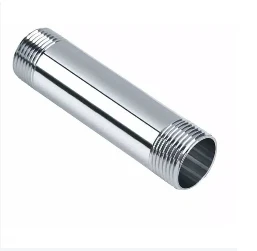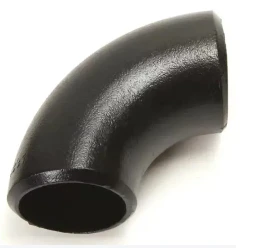JIS B2311 mangrupikeun Standar Industri Jepang anu nyertakeun kelengkapan pipa las butt, kalebet tutup anu dianggo dina sistem pipa. Caps butt-las ngawula Tujuan nutup tungtung pipa a, nyadiakeun segel pikeun nyegah leakage atawa kontaminasi. Ieu mangrupikeun bubuka pikeun topi las butt JIS B2311:
- 1. JIS B2311 Standard:
- - Standar JIS B2311 netepkeun syarat pikeun desain, diménsi, bahan, manufaktur, sareng nguji fittings butt-las, kalebet caps, dina sistem pipa.
- - Standar mastikeun yén caps anu diproduksi saluyu sareng standar JIS nyumponan standar kualitas sareng cocog sareng komponén pipa anu sanés.
- 2. Butt-Welding Cap:
- - A cap butt-las, nurutkeun JIS B2311, mangrupakeun pas dirancang pikeun nutupan jeung ngégél tungtung pipe a aman, maturan panyalindungan jeung ngajaga integritas sistem piping.
- - Caps dipaké dina kaayaan dimana tungtung pipa merlukeun panutupanana, boh permanén atawa samentara, pikeun nyegah leakage, kontaminasi, atawa nyadiakeun finish kana sistem.
- 3. Bahan jeung Konstruksi:
- - Caps butt-las handapeun spésifikasi JIS B2311 sadia dina sagala rupa bahan kayaning baja karbon, stainless steel, sarta baja alloy pikeun minuhan sarat aplikasi béda.
- - Caps ieu dijieun maké métode konstruksi standardized pikeun mastikeun sambungan kuat tur bocor-gratis lamun dilas ka tungtung pipa a.
- 4. Aplikasi sareng Kauntungan:
- - Butt-las caps manggihan aplikasi dina sagala rupa industri, kaasup minyak jeung gas, prosés kimiawi, tutuwuhan perlakuan cai, sarta leuwih dimana tungtung pipa kudu capped aman.
- - Caps nyadiakeun panyalindungan ka tungtung pipa tina elemen lingkungan, nyegah kontaminasi, sarta mantuan ngajaga kabersihan jeung integritas sistem piping.
- 5. Instalasi sareng Las:
- - Prakték instalasi anu leres, kalebet alignment anu leres, persiapan tungtung pipa, sareng téknik las, penting nalika masang caps butt-las pikeun mastikeun segel anu ketat sareng anti bocor.
- - Welding mangrupikeun metodeu umum pikeun ngalampirkeun caps kana pipa, nyayogikeun panutupanana anu aman sareng permanén anu tiasa tahan tekanan, variasi suhu, sareng aliran cairan dina sistem.
- Kasimpulanana, caps butt-las JIS B2311 mangrupikeun komponén penting anu dianggo dina sistem pipa pikeun ngégél sareng ngajagi tungtung pipa kalayan aman. Caps ieu saluyu sareng syarat standar pikeun mastikeun kualitas, reliabilitas, sareng kasaluyuan dina aplikasi industri dimana panutupanana pipa sareng panyalindungan diperyogikeun.
What Is a Butt Welding Cap and How Is It Used in Industrial Piping?
In industrial piping systems, end-of-line sealing and branch closures require robust solutions. A butt welding cap serves as a critical component for terminating pipes securely. By providing a seamless, welded closure, this fitting maintains system integrity, prevents leaks, and supports compliance with industry standards.
What Is a Butt Welding Cap?
A butt welding cap—also called a pipe end cap or buttweld end cap—is a round fitting designed to close off the end of a pipe. It’s manufactured to match the pipe’s outer diameter and schedule, with either a hemispherical or flat face. To install, both the pipe end and cap are beveled to form a V‑groove, enabling full‑penetration, fusion welds. Common materials include carbon steel, stainless steel, nickel alloys, and other engineered grades, chosen to satisfy pressure, temperature, and corrosion‑resistance requirements.
How Is Butt Welding Cap Used in Industrial Piping?
Butt welding caps find application across oil & gas, petrochemical, power generation, water treatment, and general process industries for both permanent and temporary closures. During hydrostatic testing, technicians install caps to seal off sections of piping while monitoring for leaks. In new construction or retrofit projects, caps terminate branch lines, future tie‑in spools, or dead‑end mains until system expansion. Welders prepare each joint by cleaning and beveling surfaces, aligning the cap precisely, and executing a root pass followed by filler passes per the qualified Welding Procedure Specification (WPS). Post‑weld heat treatment and non‑destructive examination (NDE)—such as radiography or ultrasonic testing—verify weld integrity and compliance with ASME B16.9 and related standards. Additionally, temporary caps enable safe isolation during maintenance, allowing for segment testing and dewatering under regulatory protocols.
Benefits and Best Practices
Butt welding caps offer a smooth‑bore transition that minimizes flow disruption and stress concentration. Their full‑penetration welds deliver exceptional structural strength and leak resistance. To optimize performance, engineers should:
Select caps with matching material grades and wall thicknesses
Adhere to proper bevel angles and joint fit‑up tolerances
Follow qualified WPS protocols rigorously
Consider cladding or protective coatings in corrosive environments to extend service life
Regular inspection and thorough documentation ensure long‑term reliability and safe operation under demanding conditions.
Butt welding caps are indispensable components for achieving durable, leak‑proof pipe terminations in a wide range of industrial applications.
Butt Welding Cap FAQs
What is a butt welding cap?
|
What materials are commonly used?
|
What standards govern butt welding caps?
|
How are butt welding caps installed?
|
Where are butt welding caps typically used?
|
What are the advantages of threaded caps?
|
















